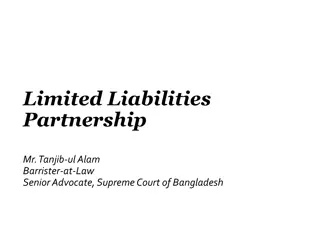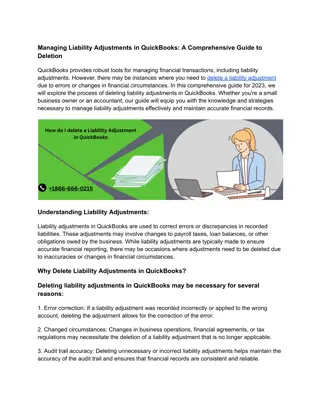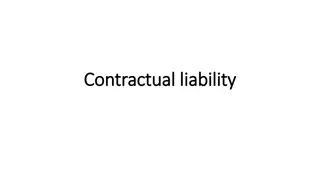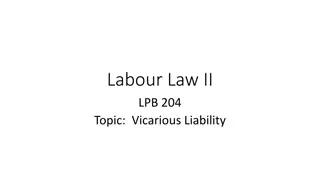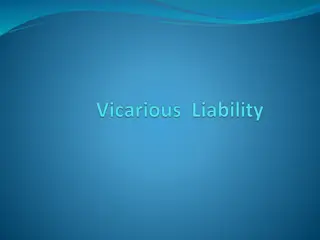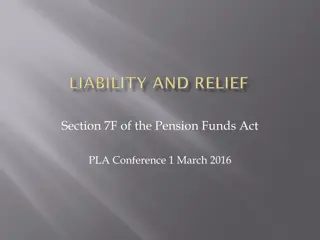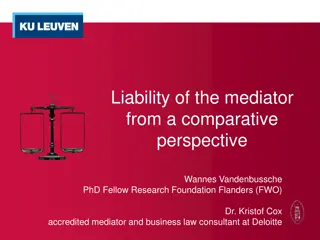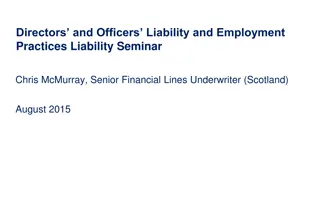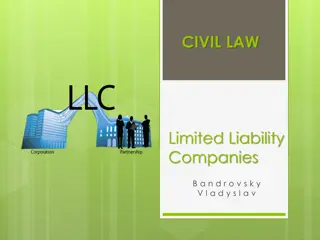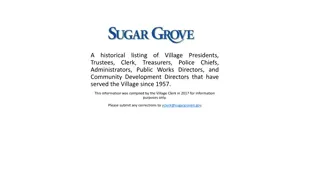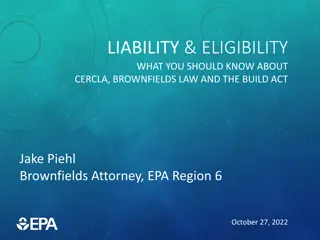Occupiers Liability Act 1957: Visitors and Duties
The Occupiers Liability Act 1957 and 1984 cover the duty of care owed by occupiers to visitors and non-visitors. The Act defines who is considered an occupier and outlines the common duty of care owed to visitors. Learn about the key statutes, the difference in scope, and the application of the common duty of care, including specific scenarios that identify who qualifies as an occupier. Gain insights into the rules of common law that apply in determining occupational control over premises.
Download Presentation

Please find below an Image/Link to download the presentation.
The content on the website is provided AS IS for your information and personal use only. It may not be sold, licensed, or shared on other websites without obtaining consent from the author.If you encounter any issues during the download, it is possible that the publisher has removed the file from their server.
You are allowed to download the files provided on this website for personal or commercial use, subject to the condition that they are used lawfully. All files are the property of their respective owners.
The content on the website is provided AS IS for your information and personal use only. It may not be sold, licensed, or shared on other websites without obtaining consent from the author.
E N D
Presentation Transcript
Occupiers liability Occupiers Liability Act 1957: Visitors
Learning Objectives By the end of the session you should be able to: Name the two statutes covering occupiers liability. 1. Identify the difference in scope of the two statutes. 2. Describe who is an occupier. 3. Describe who is a visitor under the Occupiers Liability Act 1957. 4. Explain the common duty of care under the Occupiers Liability Act 1957. 5. Explain the meaning of the term reasonable . 6. Explain the application of the common duty of care to children. 7.
A Tort Covered by Statute Law The tort of negligence comes from the common law. However, occupier s liability comes from both statute law and the common law. This area of tort involves the liability of an occupier to both visitors and persons other than visitors to his or her premises.
The Key Statutes The two key statutes are: 1. The Occupiers Liability Act 1957 which covers visitors 2. The Occupiers Liability Act 1984 which covers persons other than visitors.
Occupiers Liability Act 1957 This presentation is about the Occupiers Liability Act 1957 This act concerns the duty owed to visitors [A visitor' is often referred is a lawful visitor in textbooks in order to distinguish him/her from unlawful visitors or trespassers.]
Who is an Occupier? The Occupiers Liability Act 1957 does not define who is the occupier, but it does state that the rules of common law shall apply - s 1(2). The test to be applied is occupational control. In words: who has control over the premises?
Who is an Occupier? In Wheat v Lacon & Co four categories of occupier were identified: If a landlord lets premises then the tenant will be the occupier. 1. If a landlord who lets part of a building retains certain areas (such as an entry hall) then the landlord will be the occupier in respect of those areas. 2. If an owner licenses a person to use premises but reserves the right of entry then the owner remains the occupier. 3. If contractors are employed to carry out work on premises, the owner will generally remain the occupier, although there may be circumstances where the contractor could be the occupier. 4.
Discussion Question Who do you think would be classified as a (lawful) visitor? Hint: Consider how a person might have express or implied permissions.
Who is a Visitor? Under the common law, a visitor is a person who has express or implied permission to enter the premises. Under the Occupiers Liability Act 1957 persons who have a right to enter premises conferred by law (e.g. fire fighters and police officers) are lawful visitors.
The Common Duty of Care The Occupiers Liability Act 1957 s2 imposes a common duty of care that is owed to lawful visitors: (1) An occupier of premises owes the same duty, the common duty of care , to all his visitors, except in so far as he is free to and does extend, restrict, modify or exclude his duty to any visitor or visitors by agreement or otherwise. (2)The common duty of care is a duty to take such care as in all the circumstances of the case is reasonable to see that the visitor will be reasonably safe in using the premises for the purposes for which he is invited or permitted by the occupier to be there.
The Common Duty of Care The Occupiers Liability Act 1957 lays down guidelines in applying the common duty of care: S2(3)(a) An occupier must be prepared for children to be less careful than adults. S2(3)(b) An occupier can expect a person in the exercise of his calling, to appreciate and guard against any special risks ordinarily incident to it. S2(4)(a) A warning may discharge the duty of care. S2(4)(b) The occupier is not liable for the fault of an independent contractor provided he or she acted reasonably in entrusting the work to a contractor and took reasonable steps to ensure that the contractor was competent and the work was properly carried out.
Reasonable There are a number of references in the Occupiers Liability Act 1957 (as there are in other acts and in the common law) to reasonable . What is the meaning of reasonable ?
The Man on the Clapham Omnibus Activity Use a dictionary to find out the meaning of omnibus . Use a multimedia device to access Lord Reed s explanation of the reasonable man test in Healthcare at Home Limited v The Common Services Agency [2014] UKSC 49 paras 1-4 https://www.supremecourt.uk/decided- cases/docs/UKSC_2013_0108_Judgment.pdf
Special Categories: Children Children do not form a special category on their own, but the Occupiers Liability Act 1957 s2(3)(a) states that occupiers must be prepared for children to be less careful than adults.
Activity Use a textbook or a multimedia device to research the following cases: Hasledine v Daw [1941] Phipps v Rochester [1955] Wheat v Lacon & Co [1966] Glasgow Corporation v Taylor [1992]


![❤[READ]❤ Robotic Exploration of the Solar System: Part I: The Golden Age 1957-19](/thumb/21623/read-robotic-exploration-of-the-solar-system-part-i-the-golden-age-1957-19.jpg)
